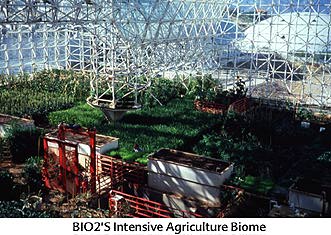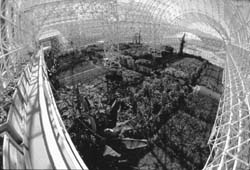

Columbia's agricultural research: high-stakes forecasting for the future
By SCOTT VEGGEBERG
ULTRA-URBAN COLUMBIA, set amidst the concrete, bodegas, and brownstones of Morningside Heights, is hardly the place you'd expect to find an ag school. But while no one is proposing to plant the front lawn of Butler Library in corn and soybeans, Columbia is nevertheless becoming a powerhouse in the search for solutions to the world's food problems as we enter the next century.Among the agricultural initiatives under way at Columbia are the projects of the Intensive Agriculture Biome at Biosphere 2. "The hope, as I see it, is to use the facility for a variety of experiments that cannot be performed anywhere else and that relate to global change issues such as increasing CO2 and its effects on plants," says Bruno Marino, a project leader at Bio2 who traces the course of carbon dioxide as it cycles among plants, soil, and air.
Francesco Tubiello, a postdoctoral fellow at the Columbia-affiliated Center for Climate Systems Research and the NASA-Goddard Institute for Space Studies, leads the agricultural research effort at Bio2. The wilderness area--with its rain forest, savanna, micro-ocean, and desert--will soon be separated from the agricultural area, which, with its three vaulting arches, will be further divvied up by enormous plastic sheets. Plans are in place for one section of the agricultural area to be held at CO2 levels close to the concentration in today's atmosphere (about 350 ppm), while another may be ramped up to double that amount and the next one to three times or higher than the current levels.
A big advantage in using Bio2 to study plant responses to CO2, as opposed to an ordinary greenhouse, is its sheer size, says Tubiello. The agricultural area stands about 60 feet high at its highest point, allowing trees to grow to maturity. But trees need to be shaken and bent to grow straight and strong, so he expects the researchers will have to train enormous fans on them to provide their daily ration of exercise.
Another plus, says Bio2 adviser Bruce Kimball of the U.S. Department of Agriculture, is that Bio2's water, air, and temperature are highly controllable. At a facility in Phoenix, Kimball grows crops and fruit trees outdoors under augmented CO2 concentrations. Orange trees grow inside what amount to open-top shower stalls, with the CO2 pumped in to maintain levels of almost 700 ppm--a level that might be expected sometime in the mid- to late 21st century. CO2, Kimball has found, acts as a fertilizer, doubling the production of oranges. Free-air CO2 enrichment (FACE) experiments with cotton in which the air in an open field was enriched to 550 ppm of CO2 showed a remarkable 40 percent increase in overall plant size and a 70 percent to 80 percent rise in fiber yield of the cotton.
 The trouble with doing CO2 enrichment experiments outdoors is that
they require literally truckloads of CO2, and one can't accurately trace
exactly where CO2 and moisture are going--whether into the air, the
soil, or the plants themselves. The tightly sealed Bio2 should prove ideally suited to answering
such questions as where all the CO2 goes once it leaves a car's tailpipe
or a factory smokestack, says Joe Berry, senior staff scientist
at the Carnegie Institution of Washington and Stanford University.
The trouble with doing CO2 enrichment experiments outdoors is that
they require literally truckloads of CO2, and one can't accurately trace
exactly where CO2 and moisture are going--whether into the air, the
soil, or the plants themselves. The tightly sealed Bio2 should prove ideally suited to answering
such questions as where all the CO2 goes once it leaves a car's tailpipe
or a factory smokestack, says Joe Berry, senior staff scientist
at the Carnegie Institution of Washington and Stanford University.
Berry says the atmosphere currently contains about 700 gigatons (1 gigaton = a billion tons) of carbon floating about in it, while human activities, notably fossil fuel burning and deforestation, dump in an extra 17 gigatons every year. Yet when you add the numbers up, only 7 gigatons stay behind. While the oceans are known to suck up about 7 gigatons each year, the question remains: Where is the missing CO2, accounting for 3 gigatons of carbon? Berry believes experiments at Bio2 will confirm his belief that the missing sink for CO2 will turn out to be land plants and soil microbes, which make up the so-called terrestrial biosphere.
"As CO2 goes up, you get a stimulation of photosynthesis, and that helps to store more carbon," says Berry. "But we also know that photosynthesis, like all other biological processes, doesn't just go up continuously as CO2 goes up. Ultimately, it reaches a point where an increase in CO2 doesn't increase photosynthesis any further. That means that at some point along this trajectory that we're on, photosynthesis will become less effective at counteracting man-made CO2, so more and more of what we are adding will wind up in the atmosphere." It's at the point where the sinks fill up that CO2 levels will really climb, he says; his work could help predict whether and when that is likely to happen.
Biosphere 2 is not the only Columbia institution hosting global agriculture projects. In addition to being scientific overseer for Bio2, Lamont-Doherty has its own agricultural work under way. Senior scientist Mark Cane has found a link between El Niño, the periodic shift of exceptionally warm waters from the western Pacific Ocean to the east, and droughts in southern Africa.
"With an El Niño there is a warming from the coast of South America to the international dateline, which is a quarter of the way around the Earth--enough to jerk the whole atmospheric circulation around. So it rains in the desert areas in Peru; there are fewer Atlantic hurricanes; you have droughts in Australia and Africa," Cane says.
In particular, Cane has found a link between El Niño and the droughts and disastrous maize harvests that periodically afflict Zimbabwe. With this information, he hopes someday to steer officials toward appropriate actions such as planting drought-tolerant crops whenever there are signs of an impending El Niño event.
 The link between
global climate changes and agriculture is also being explored at the Center for Environmental Research and
Conservation (CERC): Three Columbia professors (Cane, Don Melnick of CERC, and
Geoffrey Heal of the Graduate School of
Business) head a project to assess El Niño/Southern Oscillation effects on
Indonesia's climate, ecology, economy, agriculture, and human health. Radley Horton, a
CERC researcher on this project, points out, "If you have lower agricultural productivity
because of drought, farmers might attempt to maintain production levels by expanding their
activities into previously forested lands," he explains. Increased deforestation of this sort on a
global scale probably would magnify the greenhouse effect, which some fear could warm the
Pacific Ocean enough to make El Niño conditions the norm rather than the exception.
The resulting disruption of rainfall patterns would complete the cycle, fueling more rapid rates
of forest destruction.
The link between
global climate changes and agriculture is also being explored at the Center for Environmental Research and
Conservation (CERC): Three Columbia professors (Cane, Don Melnick of CERC, and
Geoffrey Heal of the Graduate School of
Business) head a project to assess El Niño/Southern Oscillation effects on
Indonesia's climate, ecology, economy, agriculture, and human health. Radley Horton, a
CERC researcher on this project, points out, "If you have lower agricultural productivity
because of drought, farmers might attempt to maintain production levels by expanding their
activities into previously forested lands," he explains. Increased deforestation of this sort on a
global scale probably would magnify the greenhouse effect, which some fear could warm the
Pacific Ocean enough to make El Niño conditions the norm rather than the exception.
The resulting disruption of rainfall patterns would complete the cycle, fueling more rapid rates
of forest destruction.
The answers aren't all in, but the weather forecast for the 21st century may not necessarily call for hotter summers and warmer winters as much as for a permanent change in the rainfall patterns that so many of the billions of people on Earth have come to depend on. "Most of the people who live on the globe are living from rainfall to mouth," says Carnegie's Berry. "There isn't enough stream flow to do any more irrigation than we're currently doing."
As rising CO2 giveth in the form of bumper crops for some parts of the world, it conceivably also taketh away by making deserts out of formerly fertile lands--leading to famine, mass migration, and war. It's a high-stakes forecast, one that's worth getting right.
Related links...
SCOTT VEGGEBERG is a free-lance science and environmental writer whose work has appeared in New Scientist (London), The Scientist, and other publications. His Metanews piece on Biosphere 2's media image appeared in 21stC's Winter 1996 issue.PHOTO CREDITS: Tilak Mahato / ©1995 Decisions Investments Corp.; C. Allan Morgan / ©1993 Space Biospheres Ventures




